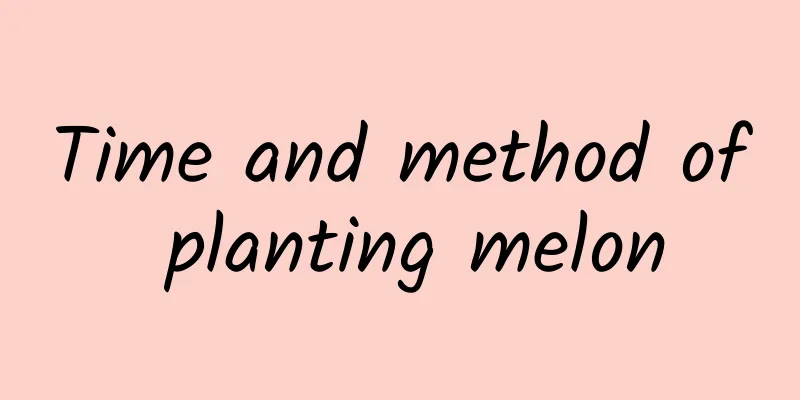Which month is the best time to plant loofah?

|
When summer comes, many people have no appetite due to the hot weather, but some common summer vegetables are often in demand by consumers, such as Hiei loofah and bitter melon. Many farmers in rural areas in both the north and south of my country grow loofah. So which month is the best time to plant loofah? Which month is the best time to plant loofah? The best time to plant loofah varies depending on the climatic conditions of the region. In general, the planting time of loofah is mainly concentrated in spring and summer. Spring planting usually takes place from late April to mid-May, which is the main period for the growth of loofah. The climate is suitable, which is conducive to the growth and fruiting of loofah. Summer loofah can be planted before early to mid-July, but attention should be paid to heat prevention and cooling to prevent high temperatures from having an adverse effect on the growth of the loofah. In addition, loofah has strong adaptability to climate and soil, prefers warm environment and is resistant to high temperature. Its seeds can germinate better in an environment of 28~35℃. In terms of soil, loofah is not very demanding on the soil, but fertile, organic-rich, well-drained loam or sandy loam is ideal. Notes on harvesting loofah 1. Determine the appropriate time for harvesting Luffa may be affected by diseases and pests during its growth, so pesticides are used in the prevention and control process. There is a safe interval after the use of pesticides, which is the time from the last application of pesticides to the time when crops can be safely harvested. Generally, crops should not be harvested within 10 days after application to avoid pesticide residues. In addition, the choice of harvesting time should also take into account the maturity of the loofah. Harvesting too early will reduce the yield and quality, while harvesting too late will affect subsequent growth and storage. Adjust the harvesting time in time according to market demand and seasonal changes. 2. Avoid harvesting on rainy days or when there is heavy dew. Harvesting loofah on rainy days or when there is heavy dew may cause the fruit wounds to be difficult to heal, increase the risk of diseases and insect pests, and easily cause rot in hot seasons. Therefore, sunny weather should be chosen for harvesting to ensure the quality and safety of the loofah. 3. Stop irrigation before harvesting For loofah supplied to other markets, irrigation should be stopped 3 days before harvesting to reduce the moisture content in the fruit, reduce the risk of rot during transportation, improve storage resistance, and extend the shelf life. This is especially important for long-distance transport. 4. Avoid harvesting under high temperatures and strong sunlight The best time to harvest is in the early morning after the dew has dried up. The temperature is lower at this time and the loofah is not heated, which helps to maintain its quality. Harvesting under high temperature and strong sunlight will increase the respiration rate of the loofah, accelerate the consumption of nutrients, affect the quality, and easily cause rot and deformation. 5. Correct harvesting method Loofah can be harvested multiple times. When harvesting, hold the melon with one hand and use scissors with the other hand to cut it about 1 cm away from the stem. Then gently wipe the dirt on the surface of the fruit and pack it according to the commodity grade. In short, when choosing the best time to plant loofah, one should mainly consider the local climate and soil conditions to ensure that the loofah can grow in a suitable environment. If grown in a greenhouse or greenhouse, the planting time can be more flexible because the temperature and humidity can be easily controlled.
|
<<: How to grow Phalaenopsis at home? What to do if the flower stems do not grow
Recommend
How many years does the ginkgo tree bear fruit?
Introduction to Ginkgo Tree Fruit Ginkgo trees pr...
How long does it take for small hibiscus cuttings to take root? Cutting methods and post-cutting management
Rooting time of hibiscus cuttings When you want t...
How to grow Chinese evergreen in water quickly
1. Temperature The ideal growth temperature for C...
When does verbena bloom?
Verbena flowering period Its flowering period sta...
The difference between Crinum orchid and spider orchid
The difference between Crinum orchid and spider o...
Cultivation methods and maintenance matters of old boxwood piles
How to grow boxwood into an old pile Boxwood is s...
What does jasmine look like and what does it represent?
1. What does it look like? Jasmine, also known as...
The reason why the leaves at the bottom of small roses turn yellow
1. Too much water Reason: The leaves at the botto...
What flowers are suitable for growing in Suqian? What are the city flowers and trees?
1. Climate characteristics of Suqian Suqian has a...
How to care for Kalanchoe when it has buds (how to water and fertilize Kalanchoe when it has buds)
How to care for Kalanchoe after it buds How to ma...
Mountain rose cultivation methods and precautions
How to grow mountain roses Matrix If it is raised...
How to prune jade trees to make them look good
After pruning the jade plant, you should water it...
How to arrange jasmine flowers so that they can take root?
Jasmine is a plant that is easy to grow by cuttin...
The role of the city that never sleeps
The value of the city that never sleeps The plant...
When and how long does garlic take to harvest?
Garlic harvest time Garlic can be sown in spring ...









